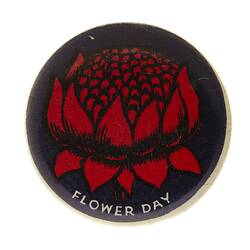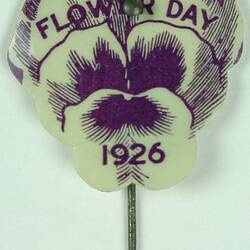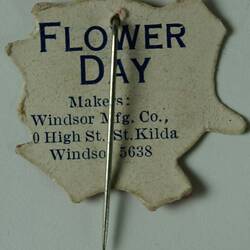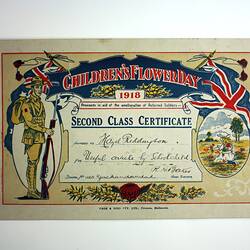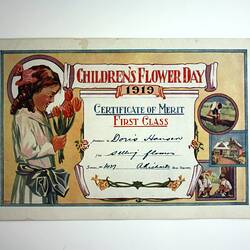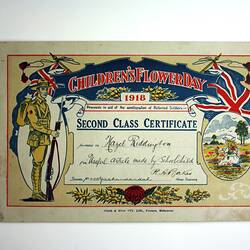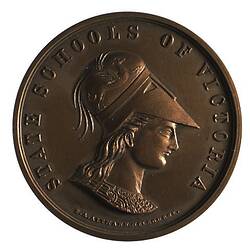Summary
Alternative Name(s): Button
Children's Flower Day badge, issued during 'peace year', 1919.The seven pointed star border symbolises the seven states of Australia.
One of 13 fundraising badges originally attached to a blue velvet ribbon. The badges all date from the World War I era, 1914-1919. They were purchased or collected by the donor's great-grandmother, Mrs Lillie Mary Holinger. The Holinger family lived at Panton Hill when World War I broke out. They moved to Canterbury, Melbourne, in 1918, and in the 1930s moved to Ferny Creek. Mrs Holinger's daughter, also Lillie Mary, born in 1896, married returned serviceman David James Gillespie in 1922.
Badges were displayed on ribbons during and after World War I, commemorating involvement in the war effort. Rosalie Triolo notes that children particularly enjoyed displaying badges that they had bought as fund-raisers for the war. One former child, Winifred Grassick, remembered that Red Cross buttons were posted to schools each month by the Education Department. to be sold for a shilling each. 'They surely must have raised a significant sum because they were a regular feature of even our small school. We took an interest and pride in being able to display a ribbon containing the whole sequence', she remembered. (Rosalie Triolo, 2012, 'Our Schools and the War', p.81).
The badges have been removed from their original ribbon by Museum Victoria staff for conservation reasons.
Flower Day had its origins in the League of Young Gardeners, created in Victoria in 1916 to 'swell the war relief fund, by cultivating garden plots at home'. From this movement sprang several 'Flower Days' which raised £126,354 for war relief. In 1916, the Victorian Education Department instructed teachers to promote gardening initiatives, and announced that there would be a November Flower Day. The main event of the Day was to be a fund-raising flower show from school gardens - 'Let the children feel that the show is to be their show', advised Supervisor of School Gardening, Cyril Isaac. At schools, the day consisted of morning lessons on war-related topics; in the afternoon schools set up street stalls to sell bouquets and button holes. The main show was not held in 1918 due to stringent war economies, but £50,000 was still raised. The event petered out after World War I.
Physical Description
Coloured image of cottage inside star-shaped outline. Inscription above and below.
More Information
-
Collecting Areas
-
Acquisition Information
Donation from Mrs Bronwyn Mitchell, 15 Feb 1994
-
Place & Date Used
-
Inscriptions
Text Obverse:' CHILDREN'S FLOWER DAY 1919 / PEACE YEAR'
-
Classification
-
Category
-
Discipline
-
Type of item
-
Object Measurements
3.2 cm (Width)
-
References
Information on Flower Day from the Australian War Memorial web site - record for REL39124 - Fundraising badge : Children's Flower Day 1919 Peace Year, [Link 1] accessed 27/9/2012; and Rosalie Triolo, 2012. 'Our Schools and the War', pp. 88-90.
-
Keywords
Flower Days, Wars & Conflicts, World War I, 1914-1918, World War I Fundraising




